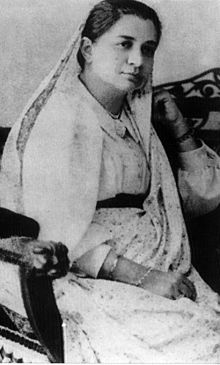Our website is made possible by displaying online advertisements to our visitors.
Please consider supporting us by disabling your ad blocker.
Bhikaiji Cama
Madam Bhikhaiji Cama | |
|---|---|
 | |
| Born | 24 September 1861 |
| Died | 13 August 1936 (aged 74) |
| Organisation(s) | India House, Paris Indian Society, Indian National Congress |
| Movement | Indian independence movement |
| Spouse |
Rustom Cama (m. 1885) |

Based on the Calcutta Flag, the green, yellow and red fields represent Islam, Hinduism, and Buddhism respectively. The crescent moon and the sun again represent Islam and Hinduism, respectively. The eight lotuses in the upper register represent the eight provinces of British India. The words in the middle are in Devanagri script and read Vande Mataram "[We] Bow to thee Mother [India]", the slogan of the Indian National Congress.
The design was adopted in 1914 as the emblem of the Berlin Committee (later known as the Indian Independence Committee). The original "Flag of Indian Independence" raised by Cama in Stuttgart is now on display at the Maratha and Kesari Library in Pune.
Bhikhaiji Rustom Cama[n 1] (24 September 1861 – 13 August 1936) or simply as, Madam Cama, was one of the prominent figures in the Indian independence movement.
Bhikaiji Cama was born in Bombay (now Mumbai) in a large, affluent Parsi Zoroastrian family.[1] Her parents, Sorabji Framji Patel and Jaijibai Sorabji Patel, were well known in the city, where her father Sorabji—a lawyer by training and a merchant by profession—was an influential member of the Parsi community.
She unfurled one of the earliest versions of flag of independent India on August 22, 1907 and she was the first person to hoist an Indian flag in a foreign nation, at the International Socialist Conference at Stuttgart.[2]
Like many Parsi girls of the time, Bhikhaiji attended Alexandra Girls' English Institution.[3] Bhikhaiji was by all accounts a diligent, disciplined child with a flair for languages.
On 3 August 1885, she married Rustom Cama, who was the son of K. R. Cama.[4] Her husband was a wealthy, pro-British lawyer who aspired to enter politics. It was not a happy marriage, and Bhikhaiji spent most of her time and energy in philanthropic activities and social work.
Cite error: There are <ref group=n> tags on this page, but the references will not show without a {{reflist|group=n}} template (see the help page).
- ^ Acyuta Yājñika; Suchitra Sheth (2005). The Shaping of Modern Gujarat: Plurality, Hindutva, and Beyond. Penguin Books India. pp. 152–. ISBN 978-0-14-400038-8.
- ^ Pal, Sanchari (24 September 2016). "The Untold Story of Bhikaji Cama". The Better India.
- ^ Darukhanawala, Hormusji Dhunjishaw, ed. (1963), Parsi lustre on Indian soil, vol. 2, Bombay: G. Claridge.
- ^ John R. Hinnells (28 April 2005). The Zoroastrian Diaspora : Religion and Migration: Religion and Migration. OUP Oxford. p. 407. ISBN 978-0-19-151350-3. Retrieved 19 August 2013.
Previous Page Next Page


